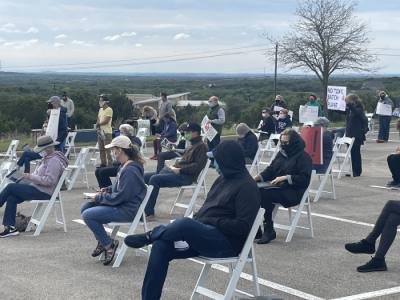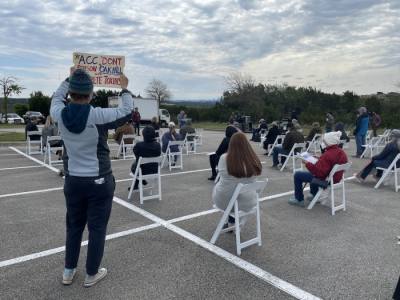“The dust blew against our house every day,” Robbins said. “It was horrible. I’m afraid the same thing will happen with the batch plant.”
The temporary concrete plant is being proposed by Colorado River Constructors, the contractors for the $674 million Oak Hill Parkway project, which will break ground this summer and aims to address congestion near the intersection of W. Hwy. 290 and Hwy. 71 at The Y at Oak Hill, according to the Texas Department of Transportation.
Although CRC considered four different sites as possibilities for its temporary plant, CRC spokesperson Laurie Simmons said ACC Pinnacle is the company’s preferred choice. Compared to other locations, she said the Pinnacle site will provide the largest buffer possible to nearby residential areas.
“That has been CRC’s goal from the beginning,” she said.
CRC held an in-person information session at the Pinnacle Campus on April 17 to present details about the proposed plant and to answer community questions. During the meeting, residents held up signs reading "No toxic batch plant" and "Don't poison Oak Hill" in protest of the plan, while representatives with CRC compared Pinnacle to the three other site options.
Two options are located within the project’s right of way near the Scenic Brook community and The Y intersection itself. The third, which CRC said was recently removed from consideration, was a vacant property outside of the Ledgestone community.
The argument for using Pinnacle
Although a final contract has not been signed by ACC, trustees in March authorized Chancellor Richard Rhodes to enter a contract with CRC that would allow the company to rent the Pinnacle Campus for parking, storage and operations. The campus has not been in operation since 2018, and the project would not impact future planing for the campus, according to ACC.
If approved, the batch plant will take up a third of an acre on the 58-acre Pinnacle site, while other parts of the campus will be used for staff parking; as an equipment and tools yard; and to store sand, rock and other materials, according to CRC. The plant would be in operation for an estimated three years with work conducted both during the day and at night.
Benefits to the Pinnacle site, according Simmons, include its central location within the Oak Hill Parkway project’s scope; traffic signals at access points in and out of the site; and existing asphalt lots and roadways that can contain water, dust and materials better than a dirt surface.
In terms of the plant’s impact on neighbors, Simmons said it would be located 200 yards from the closest residential properties, farther than any of the other sites being considered. Tree coverage surrounding the campus can also help mitigate noise and light pollution, she said.
ACC Pinnacle also offers access to electricity, which is not available at other sites. Simmons said electricity would allow CRC to operate without using a diesel engine to generate power, reducing air emissions overall.
Keeping trucks onto the asphalt roads instead of temporary dirt roads will reduce dust emissions, and materials will be kept wet to weigh it down and reduce it from blowing into the air with the wind.
“There's going to be continuing watering of rock and sand material piles before it's ever loaded on to the conveyor belt,” she said. “There's a dust collector over the conveyor because [we’re] trying to make sure we collect as much dust as possible. There’s a pressurized system to make sure that there's no cement that reaches in the air, and the central mixing units are completely enclosed.”
Resident concerns
Residents in attendance April 17 asked dozens of questions with concerns ranging from the site’s proximity to area homes and apartments to air quality and construction timelines.
Responding to calls to locate the plant farther from the project, Simmons said a plant away from the Oak Hill area would result in increased truck emissions driving to and from the site, increased traffic on roadways and a longer construction timeline for the project.
When asked why CRC could not utilize existing, privately owned batch plants in Southwest Austin, she said those in the area do not have the capacity nor means to create the wet concrete needed for the project.
“CRC has not convinced me that it cannot be put at an existing plant like Tex-Mix,” Robbins said. “They’re basically putting it closer for their convenience. It’s not our neighborhood's responsibility to be the staging area for their convenience.”
Despite CRC outlining plans to reduce emissions from the site, residents, including Robbins, said they believed the site’s elevation will make it susceptible to frequent winds that blow toward the neighborhood behind the site.
Project Manager Pike Riegert said the amount of dust leaving Pinnacle should be minor. Also, he said the dust created by the excavation involved in the road project itself, regardless of where a concrete plant may be located, will be far greater than that created by the plant.
“Excavating rock on the project for the road will be dustier and probably more impactful than any batch plant,” he said. “Pinnacle really meets all of our location factors, and that's why we feel is the best place.”
Austin City Council Member Paige Ellis, who represents Oak Hill and attended the meeting, told Community Impact Newspaper that her office has heard concerns throughout the project’s planning about the various proposed plant locations. She said the meeting was a good opportunity for residents to ask for clarifications.
“It's clear residents know what's going on in their community, and they deserve to have answers for all of these bits and pieces,” she said.
Next steps
CRC and the community college district are still negotiating a rental contract for Pinnacle.
If an agreement cannot be reached between the two sides or if the site is not granted zoning approval by the city of Austin through permitting, CRC would utilize both the Scenic Brook and The Y at Oak Hill sites as its final choices. Scenic Brook would be an estimated 100 yards away from homes, while The Y site would be 25 yards away.
“If CRC has to use those right away locations and ACC Pinnacle is not available, we will use both the Scenic Brook location as well as The Y location at different points of the project,” Simmons said. “We would have to move it throughout the project to accommodate the actual construction.” Riegert said Oak Hill Parkway has received full approval, and the current, finalized design reflects what will ultimately be built. The project, funded by state revenue, will create a roadway as wide as 12 lanes near the Y at Oak Hill where SH 71 and Hwy. 290 intersect. TxDOT also will construct flyovers at the interchange of those two roads an estimated 25 feet high while excavating the main lanes of Hwy. 290 to approximately 18 feet below grade level to pass beneath the flyovers.
According to TxDOT, the Oak Hill Parkway project will break ground this summer, and construction could take up to five years to complete.
Steve Beers, Save Barton Creek Association board member, said the concrete plant is one thing, but he is more worried about the other environmental disruption caused by construction overall.
“They keep saying it’s a done deal, but we keep wanting them to convert the existing roads without the elevated and excavated highway that’s in their plan,” he said.
Robbins said he believes traffic on W. Hwy. 290 has to be addressed, but the project as approved is too large for the community.
“This isn’t building Oak Hill Parkway; it’s the Dripping Springs Expressway,” he said. “It will marginally help the people here, but it will destroy the character of our neighborhood, and at the same time it’s allowing easy access to the suburbs beyond Oak Hill.”







